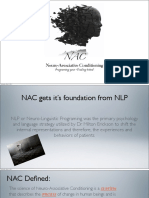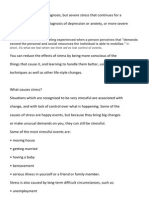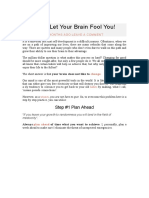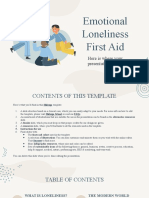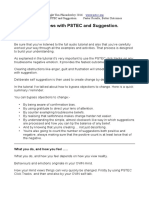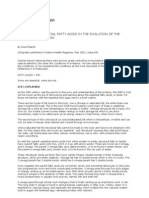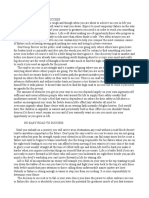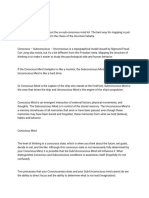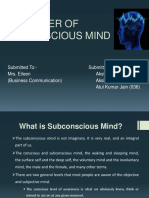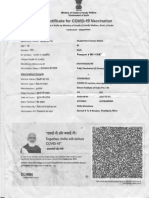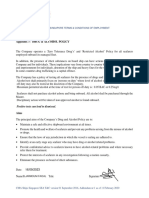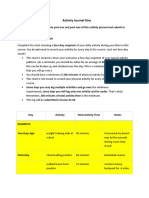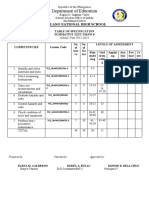0 ratings0% found this document useful (0 votes)
72 views97 pagesControl Your Subconscious Mind
Uploaded by
mahalaxmiastrovastuCopyright
© © All Rights Reserved
We take content rights seriously. If you suspect this is your content, claim it here.
Available Formats
Download as DOCX, PDF, TXT or read online on Scribd
0 ratings0% found this document useful (0 votes)
72 views97 pagesControl Your Subconscious Mind
Uploaded by
mahalaxmiastrovastuCopyright
© © All Rights Reserved
We take content rights seriously. If you suspect this is your content, claim it here.
Available Formats
Download as DOCX, PDF, TXT or read online on Scribd
You are on page 1/ 97
Preface
This book is all about you & your subconscious mind.
The mind you can control and the one you potentially
cannot .
This book will guide you to have control over your
subconscious mind and how to deal with it .
This book is divided into various chapters having its own
relevance .
If one is unable to have a firm hold over their
subconscious mind , it is no less than a nightmare due to
uncontrolled thought processes not relevant in any
instance .
About the author
Harshita bansal is a certified & qualified finance
professional & having an expertise in cognitive &
financial psychology .
The author has published various books on cognitive
finance , financial & investor psychology
The author has certifications from the top tier institutes
such as NISM , NCFM , AIWMI etc , Having an
experience of 3 years .
Foreword
We can view consciousness as three distinct
levels: the conscious, the subconscious (or
preconscious), and the unconscious.
The first level of consciousness is known as the
conscious state, and this refers to our immediate
awareness that you are experiencing as you read
this.
We make use of our conscious mind when we
take in input from our senses, analyze the
information, and then make decisions based on
this information.
Table of contents
● Chapter 1: What is the subconscious mind ?
● Chapter 2 : Power of subconscious mind
● Chapter 3 : Conscious mind vs subconscious mind
● Chapter 4 : Control over subconscious mind
● Chapter 5 : The psychodynamic approach
● Chapter 6 : The dreams interpretation
● Chapter 7 : The espionage within
CH-1 : What is the subconscious mind ?
Subconscious mind makes up around 95% of
your brain power and handles everything your
body needs to function properly, from eating
and breathing to digesting and making
memories.
Subconscious mind stores everything you see. It
permanently stores everything that ever happens
to you, and its capacity is virtually unlimited.
Therefore sometimes we see something and it
occurs in our dreams , the subconscious mind is
responsible for dreams.
Homeostasis :
Homeostasis is any self-regulating process by
which an organism tends to maintain stability
while adjusting to conditions that are best for its
survival. If homeostasis is successful, life
continues; if it's unsuccessful, it results in a
disaster or death of the organism.
Subconscious mind also practices homeostasis
in your mental realm, by keeping you thinking
and acting in a manner consistent with what you
have done and said in the past.
Subconscious mind causes you to feel
emotionally and physically uncomfortable
whenever you attempt to do anything new or
different or to change any of your established
patterns of behavior.
Subconscious mind is similar to a computer
program , the codes you enter into the system
will result accordingly .
If you think in an optimistic manner , your
subconscious mind will try to be positive and
make you feel positive .
Chapter : 2 power of subconscious mind
Subconscious mind has something called a
homeostatic impulse, which regulates functions
like body temperature, heartbeat and breathing.
Through your autonomic nervous system, your
homeostatic impulse maintains a balance among
the hundreds of chemicals in your billions of
cells so that your entire physical machine
functions in complete harmony most of the time.
Your mind is constantly filtering and bringing to
your attention information and stimuli that
affirms your preexisting beliefs.
This is known in psychology as confirmation
bias as well as presenting you with repeated
thoughts and impulses that mimic and mirror
that which you've done in the past.
It is also the realm in which you can either
habituate yourself to expect, and routinely seek
the actions that would build and reinforce the
greatest success, happiness, wholeness or
healing of your life.
The function of your subconscious mind is to
store and retrieve data.
Its job is to ensure that you respond exactly the
way you are programmed.
Your subconscious mind makes everything you
say and do fit a pattern consistent with your
self-concept, your “master program.”
Every moment that you are awake, your five
senses are taking in a constant stream of
information.
These experiences are stored as memories, like a
computer stores data. But we do not need to
actively recall most of this information.
Studies in the field of psychology on how the
brain works indicate that the experiences we
have shape the way we think and act, especially
experiences in our early childhood.
Although you do not remember most of your
life data, the unconscious data in your head
influences 90 to 95% of your behavior.
It is constantly running programs to control how
we walk, sit, breathe, talk, and so on. We don’t
have to think about these things, they just
happen because the information to do them is
stored in your brain.
Few quick facts about subconscious mind :
1 ) The Subconscious Mind dreams :
Dreams have been studied since the dawn of
time by scientists, philosophers and theologians
with a myriad of different theories and
interpretations.
Sigmund Freud famously explained dreams as a
window into our unconscious and a
manifestation of our deepest desires and
anxieties and repressed childhood memories or
obsessions.
2 ) Subconscious Mind controls 95 percent of
your life :
Not all that surprising really as our
subconscious mind controls each and every
physical movement, whether voluntary or
involuntary.
Today's science estimates that 95 percent of our
brain's activity is unconscious, meaning that the
majority of the decisions we make, the actions
we take, our emotions and behaviors, depend on
the 95 percent of brain activity that lies beyond
conscious awareness.
3 ) The Subconscious Mind is always awake :
Your subconscious mind never sleeps, rests or
takes a break because it controls all vital
processes and functions of the body.
For instance, the subconscious mind controls
heartbeat, blood circulation, regulates digestion
and elimination.
In sleep our conscious mind becomes dormant
while the subconscious mind stays fully awake.
Science shows that we still hear and process
everything even while asleep.
4 ) The Subconscious Mind is habit-based :
As we go about our daily routine such as
waking up, traveling to and from work, eating,
drinking and going to sleep it becomes second
nature, we’ve formed habits.
This is because we process information quickly
and without being aware, this is the unconscious
mind at work.
Freud believed the unconscious mind does most
of the work of our daily activities without us
even realizing it.
5 ) The Subconscious Mind takes everything
literally :
The subconscious mind has the habit of taking
everything literally.
It does not differentiate between negative and
positive. So if you continually tell yourself that
you’ll never succeed in a particular venture, it’s
likely to turn out that way.
The subconscious mind is subjective. It doesn’t
think or reason independently, it simply obeys
the commands it receives from your conscious
mind.
As Henry Ford said, “if you think you can, or if
you think you can’t, you’re right!”
6 ) The Subconscious Mind is present-based :
When we dream about the future or get
nostalgic thinking of the past, it is the conscious
mind that’s at work.
The conscious mind thinks in terms of past and
future, rather than the present.
Our subconscious mind is constantly focused on
the present moment.
This is why it’s so important to be mindful of
your inner thoughts such as; “I am successful”
rather than “I will be successful”.
7 ) The Subconscious mind is like a computer
processor :
Computers were originally designed around the
brain model, and at one time were called
electronic brains.
The human body functions much in the same
way to modern day computers or rather,
computers operate in much the same way to the
most complex processing unit there has ever
been – the human brain.
The subconscious mind is far more powerful
than the conscious mind and can process huge
quantities of information that come via your five
senses and translate them back to your brain in
the blink of an eye.
8 ) The Subconscious Mind is primal :
Our subconscious mind communicates in
images, feelings and metaphors focusing on
emotion rather than logic or reason.
Our intuition is the complex system in the brain
that acts like a bridge between the subconscious
and the conscious mind. It’s the process of the
brain that requires no analytical reasoning.
9 ) The Subconscious mind is a multi-tasker :
Although many of us think we can multitask,
the truth is that it’s quite impossible to be
consciously focused on two things at once.
When we try to pay attention to two things at
once the brain gives its neuronal attention to one
thing, then the other, then back to the first thing.
We are never able to give simultaneous
attention to two things at once.
Equally it’s physically impossible to feel happy
and sad at the same time or angry and calm, but
we can switch between emotional episodes very
quickly. Our subconscious however is a born
multi-tasker.
In contrast, your subconscious mind is always
working in the background, but you are not
necessarily aware of it.
Sometimes called the unconscious mind, your
subconscious mind contains all of the stored
information of everything you have ever
experienced.
Because of this, it influences how you react to
things, such as why you are shy, lazy, eat too
much, or have an addiction.
On the positive side, your subconscious mind
also affects things like why you are motivated,
confident, successful, cheerful, hopeful and so
on.
The key is using your consciousness to
positively influence your subconscious
thoughts.
Learning how to use the two together is a
powerful tool.
You can use your consciousness to reprogram or
retrain your subconscious mind to do things that
are more beneficial to your world now and for
your future.
Do you have goals you want to reach, habits that
seem impossible to overcome, hopes for a
dream job that would change your life, or a
vision of the future that looks very different
from today?
Using your conscious thoughts to program your
subconscious mind can bring you the success in
all areas of your life that you are looking for.
Contrary to the conscious mind, where we can
and readily acknowledge feelings and cognition,
we define unconsciousness as a deeper mental
process.
Scientists have agreed that it’s difficult and
almost impossible to measure unconscious mind
events because it’s not a neuroanatomical
structure.
The unconscious is a process that happens
automatically. Human’s conscious thoughts
can’t examine this process because it occurs
underneath the conscious awareness.
However, researchers have hypothesized that
the unconscious affects human behavior.
According to Freud, the unconscious stores all
repressed thoughts and feelings.
These thoughts and feelings can manifest in
both everyday and unexpected situations, often
caused by a trigger.
For instance, suppressed hatred towards one’s
father’s alcoholism can be triggered by the
smell of liquor.
It’s theorized that it’s difficult to measure the
unconscious mind, but Freud believed we could
access it through psychoanalytic therapy.
Through psychoanalysis, the unconscious can be
“lured” out because it’s thought that repressed
thoughts and feelings are the sources of many
psychological issues.
Examples of unconscious events include
suppressed feelings, auto reactions, complexes,
and concealed phobias.
Historically, feelings, thoughts, and responses
that are outside of a human’s consciousness
were attributed to a divine’s role in dictating a
motive or action.
The most common example of unconscious
behavior is the Freudian Slip.
It’s a phenomenon where a person makes a
memory or a verbal mistake e.g. calling a
spouse’s name by the ex’s name or using the
wrong word for something.
Listeners often interpret these mistakes as the
speaker’s hidden emotions. Even though they
are seen as accidental, Freud believed it reveals
more than what it seems.
Supposedly, the slips show a much deeper and
more real secret thoughts and feelings a person
holds.
There have been some studies conducted to find
the correlation between these verbal and
memory mistakes to the unconscious.
It’s theorized that the more suppressed thoughts
and feelings a person has, the more likely he or
she to commit verbal errors.
Another example, though more complex than a
Freudian slip, is internalized racism.
Psychologists and mental health professionals
believe that even if we’re consciously against
racist ideology, everyone is likely to have some
for conditioning of internalized racism.
It’s an unsettling thought, but by understanding
and exploring our cultural make-up and
upbringing, we might be able to confront racist
conditioning.
Conditioning is an essential factor in analyzing
to know where our unconscious behaviors stem
from.
Chapter 3 : subconscious mind vs conscious mind
The term “unconscious” or “unconscious mind”
is most closely associated with Freud and
psychoanalysis, but the general notion predates
Freud by hundreds if not thousands of years.
For Freud, however, the idea of memories,
feelings, and other mental content outside
conscious awareness took on a new, practical
significance.
It was a key element of the theory he was
developing to explain the causes of mental
disorders and how to treat them.
Put in the simplest terms, Freud theorized that
hidden mental contents were making people
“ill.”
As he understood it, these mental contents had
been “repressed” and made unconscious.
It was a broad and powerful idea—and if
debates over dinner are any evidence—one that
continues to be interesting.
As for the term “subconscious,” Freud used it
interchangeably with “unconscious” at the
outset.
The words are similarly close but not identical
in German (subconscious is das Unterbewusste;
unconscious is das Unbewusste).
But he eventually stuck with the latter term to
avoid confusion. He couldn’t have predicted
that the confusion would still exist after more
than 100 years of discussion.
In professional writing, the meaning of
“unconscious” varies somewhat depending on
context.
Generations of psychoanalysts have debated the
function of an unconscious, or how and why
certain mental contents get repressed.
The way that an analyst understands the
unconscious often is instrumental for how he or
she tries to fulfill one of the central aims of the
“talking cure,” which is to help a patient achieve
relief by making the unconscious conscious.
Some neuroscientists find the concept of an
unconscious to be a problem, because the
terminology implies that the unconscious is a
place, a true anatomical location, as it were, in
the brain.
Freud, as a neurologist, did think in terms of
neurobiology. But he didn’t have twenty-first
century tools to help him analyze the structure,
function and complex interactions among nerve
cells, neural circuits, or brain regions.
Today, most psychoanalysts and
psychodynamically-oriented therapists do not
think of the unconscious as a neuroanatomical
structure.
Rather, they use the term as shorthand to refer to
a complex, but familiar, psychological
phenomenon.
That is, a good deal and perhaps most of our
mental life happens without us knowing much
about it. Neuroscientists are clued into these
processes too.
So they appreciate that any understanding of the
neurobiology of mental life must go beyond
conscious thoughts and feelings.
You can derive the subconscious through
introspection that you can likely identify your
behavior subconsciously, motivation, or
impulse.
The unconscious can’t be, for lack of a better
word, “summoned.” For example, it would be
much harder to derive or determine the point of
origin for your deep-seated phobia, but you can
easily alter the way you breathe.
It’s not uncommon for some to use the terms
interchangeably because of their subtle
differences.
One of the easiest ways to understand them is
by imagining an iceberg. What is visible is the
conscious, while what lies below and deeper are
the subconscious and unconscious.
An iceberg is larger than what the naked eyes
can see when the entire structure is taken
together. However, both the tip and what’s
below exist more than what is noticeable. As
much as the unconscious is not available to
introspection, it’s possible to find its origin with
the help of mental health professionals.
Sigmund Freud didn't exactly invent the idea of
the conscious versus unconscious mind, but he
certainly was responsible for making it popular
and this was one of his main contributions to
psychology.
Freud (1900, 1905) developed a topographical
model of the mind, whereby he described the
features of the mind’s structure and function.
Freud used the analogy of an iceberg to describe
the three levels of the mind.
Freud (1915) described the conscious mind,
which consists of all the mental processes of
which we are aware, and this is seen as the tip of
the iceberg.
For example, you may be feeling thirsty at this
moment and decide to get a drink.
The preconscious contains thoughts and feelings
that a person is not currently aware of, but
which can easily be brought to consciousness
(1924).
It exists just below the level of consciousness,
before the unconscious mind. The preconscious
is like a mental waiting room, in which thoughts
remain until they 'succeed in attracting the eye
of the conscious' (Freud, 1924, p. 306).
This is what we mean in our everyday usage of
the word available memory.
For example, you are presently not thinking
about your mobile telephone number, but now it
is mentioned you can recall it with ease.
The unconscious mind comprises mental
processes that are inaccessible to consciousness
but that influence judgments, feelings, or
behavior (Wilson, 2002).
According to Freud (1915), the unconscious
mind is the primary source of human behavior.
Like an iceberg, the most important part of the
mind is the part you cannot see.
Our feelings, motives and decisions are actually
powerfully influenced by our past experiences,
and stored in the unconscious.
Freud applied these three systems to his
structure of the personality, or psyche – the id,
ego and superego.
Here the id is regarded as entirely unconscious
whilst the ego and superego have conscious,
preconscious, and unconscious aspects.
we are fully aware of what is going on in the
conscious mind, we have no idea of what
information is stored in the unconscious mind.
The unconscious contains all sorts of significant
and disturbing material which we need to keep
out of awareness because they are too
threatening to acknowledge fully.
The unconscious mind acts as a repository, a
‘cauldron’ of primitive wishes and impulse kept
at bay and mediated by the preconscious area.
For example, Freud (1915) found that some
events and desires were often too frightening or
painful for his patients to acknowledge, and
believed such information was locked away in
the unconscious mind.
This can happen through the process of
repression.The unconscious mind contains our
biologically based instincts (eros and thanatos)
for the primitive urges for sex and aggression
(Freud, 1915).
Freud argued that our primitive urges often do
not reach consciousness because they are
unacceptable to our rational, conscious selves.
Freud (1915) emphasized the importance of the
unconscious mind, and a primary assumption of
Freudian theory is that the unconscious mind
governs behavior to a greater degree than people
suspect.
Indeed, the goal of psychoanalysis is to reveal
the use of such defense mechanisms and thus
make the unconscious conscious.
Freud believed that the influences of the
unconscious reveal themselves in a variety of
ways, including dreams, and in slips of the
tongue, now popularly known as 'Freudian
slips'.
Freud (1920) gave an example of such a slip
when a British Member of Parliament referred
to a colleague with whom he was irritated as 'the
honorable member from Hell' instead of from
Hull.
Chapter 4 : Control over subconscious mind
1 ) Be willing to see the unchangeable change:
The first step in creating massive change in your
life is not actually believing that it's possible, it's
being willing to see if it is possible.
You are not going to be able to jump from being
a complete skeptic to a wholehearted believer.
The step between those is just being open to
seeing what could be possible.
You could maybe try sending a few "scary
emails," in which you proposition a client or
partner for something that they do not have any
reason to respond to.
You might have a few dozen ignored messages,
but eventually, someone will respond.
The point is that you're willing to see if it's
possible that's what will change your life.
2 ) Give yourself permission to be successful:
Instead of regurgitating the same old narrative
of believing you'll be happy once you're 10
pounds, one promotion and two life events
down-the-line, work on changing your inner
monologue to: "I allow my life to be good."
Give yourself permission to be happy and
successful, and not feel guilty about it.
If you have a subconscious association between
success being amoral, or corrupt, of course
you're not going to do what you need to do to
live the life you want to live.
3 ) Don't allow other people's fears to cast
shadows of doubt :
The way people respond to news of your
success will tell you how they are really doing
in their lives.
If you announce your engagement, people who
are in happy marriages will be elated for you.
People who are in unhappy marriages will warn
you that it is difficult and that you should enjoy
your remaining time as "single" individuals.
The point is that other people's fears are
projections of their own situations. They have
nothing to do with what you are or aren't
capable of.
4 ) Surround yourself with positive
reinforcement :
unfollow people who make you feel bad about
yourself and follow those who are constantly
posting motivational messages and interesting
ideas.
Make your newsfeed a place that can catalyze
your growth, instead of lessening your
perception of your worth.
5 ) Speak your success as a present fact, not a
future plan.
Though you shouldn't say things like "I drive a
convertible," or "I am a CEO," if they are not in
fact true, do start speaking about what it is you
want out of life not in the context that you will
one day pursue it, but that you are already living
it.
Instead of saying: "I hope to do that one day,"
say, "I am strategizing how to do that now."
Instead of thinking: "I will be happy when I am
in a different place in my life," think, "I am
completely capable of being happy right here
and right now, nothing is holding me back."
6 ) Recognize The Roadblock
First, you need to identify what is holding you
back from achieving what you want to achieve.
What are your limiting thoughts or fears?
For example, if your desire is to write a book,
but you just can’t seem to get started or finish,
what is keeping you from doing that?
Do you think no one will read it or you don’t
have enough time or you’re not a trained writer?
All of these thoughts are what you imagine to be
true, but they are not necessarily true.
Your unconscious mind has been programmed
to respond that way, and your conscious choices
will follow.
Roadblocks can also be physical barriers.
Perhaps you want to lose weight, but you allow
your habit of scrolling through social media for
30 minutes a day to fill the time that could be
spent exercising.
Think about your goals and dreams and find out
what thoughts, habits, ideas, or barriers are
keeping you from achieving them.
7 ) Let Go Of Limiting Thoughts
Once you know what your limiting thoughts are,
accept them, embrace them, and then let them
go.
Sometimes this requires you to bring pain to the
surface, into your conscious mind, so you can
face it and then release it.
Perhaps you struggle with the ability to develop
a trusting relationship, for example, but you
realize you did not have that modeled for you in
your childhood.
When you understand what is causing your
emotions, you can address it and find a better
way to respond.
8 ) Set Up The Intention With Your
Conscious Mind
Now it is time to unleash the power of positive
thinking and reprogram your subconscious.
Your conscious thoughts and actions can
reprogram your subconscious mind in a
heartbeat.
A positive message can reprogram how you
feel, heal trauma, and change habits that make
our lives stagnant blossom into fulfilling lives
that focus on the things that matter most.
Use your conscious mind to set an expectation
of what will happen in your life.
For example, when faced with your roadblock,
say to yourself, “Even though I’ve done this in
the past, I no longer do it now.”
Your subconscious mind will listen, just as it
has listened to all of the other input it has ever
received.
Over time, your subconscious mind has no
choice but to follow.
It is no longer interested in old habits because it
has found a new habit.
The key is visualizing what you want to happen,
having a plan for how you will react to your
roadblocks, using your conscious mind to stay
aware and recognize what’s going on, and
choosing to follow your plan in the moment.
Positive Tools To Help You Tap Into Your
Subconscious Mind
Positive Affirmations :
Your subconscious mind makes everything you
say and do fit a pattern consistent with your
self-concept, your “master program.”
This is why repeating positive affirmations are
so effective — you can actually reprogram your
own thought patterns by slipping in positive and
success-oriented sound bites.
Start every day with a positive affirmation. Say
one each time you are faced with a roadblock or
challenge.
Inspirational Quotes
Reading inspirational quotes is so impactful for
people committed to positive thinking.
By focusing your thoughts on uplifting words
and ideas, your subconscious will begin to
implement a positive pattern in your way of
thinking and your outlook on life.
Apply the same principle by reading an uplifting
article each day, reading helpful books relevant
to your life goals, listening to educational or
inspirational podcasts, and watching a
motivational video or film.
Pareto Principle
In life 80% of the outcome in anything you do is
usually the result of 20% of your total effort.
This is commonly called the Pareto Principle
and it’s very powerful once you understand it.
Follow this principle by making sure the things
you do each day are those that will have the
greatest impact on achieving your life goals.
When you make these actions a priority, they no
longer fall through the cracks, fall prey to
procrastination, or are overtaken by other
activities.
SMART Goals :
All your habits of thinking and acting are stored
in your subconscious mind.
It has memorized all your comfort zones and it
works to keep you in them.
This is why it’s so important to make writing
SMART goals a regular habit.
Over time, staying productive and focusing on
all of your goals will become part of your
comfort zone.
Power Of Positive Thinking
Your subconscious mind is subjective. It does
not think or reason independently; it merely
obeys the commands it receives from your
conscious mind.
Just as your conscious mind can be thought of
as the gardener planting seeds, your
subconscious mind can be thought of as the
garden, or fertile soil, in which the seeds
germinate and grow.
This is why harnessing the power of positive
thinking is important to the foundation of your
entire thought process. Your conscious mind
commands and your subconscious mind obeys.
Consciously choose to feed your subconscious
with positive, empowering thoughts.
Habits Of Highly Successful People
For those looking to expand their realm of
comfort zones, I highly recommend considering
the habits of successful people as they are the
patterns commonly adopted by the minds of
great leaders and thinkers.
Unlocking the power of these behaviors will
put you one step closer to being able to make
the same things happen in your life.
These habits include planning your day the
night before, numbering your priorities on your
to-do list, and completing your most important
task first.
Train Your Subconscious Mind To Create
Your Best Life
Learning techniques to reprogram your
subconscious mind will help you believe in
yourself because your confidence will no longer
be challenged by fear of the unknown. But more
importantly, doing so will train your brain to be
in line with your true desires, dreams, and life
goals
Create a vision space
Being able to imagine what it is you want out of
your life is absolutely essential for creating it,
because if you don't know where you're going,
you won't know which way to turn first.
Once you have a crystal clear image in your
mind for what it is you want and how it is you
want to live, you are then capable of beginning
to enact and create it.
If you are still hazy or torn between what you
want, you will be rendered incapable of taking
real, meaningful action toward anything.
Whether you use a Pinterest board, blog,
notebook or board, put together words and
images that represent what you want and how
you want to live.
Identify your resistance
When our subconscious minds hold us back
from pursuing something that we love, it is
because we are holding a conflicting belief
about it.
To identify your resistance, question yourself.
Ask yourself why you feel better when you
procrastinate, or why getting what you really
want could actually put you in a place that
makes you feel more vulnerable than ever.
Find a way to meet those needs before you
proceed.
Have a master plan for your life.
Forget five or even 10 year plans; so much
changes over time it's nearly impossible to set
goals that you'll be able to keep.
Most likely, new or even better opportunities
will surface, and though your life won't look
like you thought it would, you're better off for
that.
Instead, have a master plan. Identify your core
values and motivations. Ask yourself what is the
ultimate goal of what you want to accomplish
while you are alive; imagine the kind of legacy
you want to leave.
Once you have your Big Picture values
identified, you can make decisions for the long-
term that align with your true self.
Start a gratitude journal.
The best way to start putting yourself in a
headspace of "having" rather than "wanting" is
to begin a gratitude practice.
By expressing thanks for all that you do have,
you shift your mindset from being hungry for
change to feeling satisfied with where you are
at. Nothing magnetizes abundance to you like
gratitude.
There's a saying that once you believe you have
enough, you are open to receiving more and
more and more. That is undoubtedly true.
Start asking for what you want, even if you
know you'll be denied.
If someone asks you to do a consulting project,
ask for the amount of money you truly want to
earn for it.
If your goal is to get a promotion in your
organization, sit down with your higher ups and
make your intentions known. Reach out to
brands you want to work with.
Start asking for what you want, even if you have
no reason to believe that anyone will actually
give you any of those things. Eventually, they
will.
Release your attachment to the "how."
Your job is to identify the what, and then to
work in tandem with other people for the how.
If your goal is to work remotely and run your
own business, instead of giving up if your first
attempt fails, try reimagining how else you
could achieve your ultimate vision in a new way
that is more financially lucrative.
The point is that life will always surprise you
with how things come to fruition. Instead of
being obsessively attached to every little detail
working out the way you think it should, be
open to potential and possibility, even if it's
something you never imagined before.
Surround yourself with allies.
Start spending time with people who are
ambitious, supportive and creative.
If you're hanging out every weekend with
people who are likewise unhappy with their
lives, you aren't going to receive an abundance
of support if you try to break free and do your
own thing.
Remember that you will truly become who you
spend the most time with, and choose who that
is very carefully.
Chapter 5 : psychodynamic approach
The unconscious mind comprises mental
processes that are inaccessible to consciousness
but that influence judgments, feelings, or
behavior (Wilson, 2002).
According to Freud (1915), the unconscious
mind is the primary source of human behavior.
Like an iceberg, the most important part of the
mind is the part you cannot see.
Our feelings, motives, and decisions are actually
powerfully influenced by our past experiences,
and stored in the unconscious.
Psychodynamics, also known as psychodynamic
psychology, in its broadest sense, is an approach
to psychology that emphasizes systematic study
of the psychological forces underlying human
behavior, feelings, and emotions and how they
might relate to early experience.
It is especially interesting in the dynamic
relations between conscious motivation and
unconscious motivation.
The term psychodynamics is also used to refer
specifically to the psychoanalytical approach
developed by Sigmund Freud (1856–1939) and
his followers.
Freud was inspired by the theory of
thermodynamics and used the term
psychodynamics to describe the processes of the
mind as flows of psychological energy in an
organically complex brain.
There are four major schools of thought
regarding psychological treatment:
psychodynamic, cognitive-behavioral,
biological, and humanistic treatment.
In the treatment of psychological distress,
psychodynamic psychotherapy tends to be a less
intensive (once- or twice-weekly) modality than
the classical Freudian psychoanalysis treatment
(of 3–5 sessions per week).
Psychodynamic therapies depend upon a theory
of inner conflict, wherein repressed behaviors
and emotions surface into the patient's
consciousness; generally, one's conflict is
unconscious.
Psychodynamic theory states that events in our
childhood have a great influence on our adult
lives, shaping our personality. Events that occur
in childhood can remain in the unconscious, and
cause problems as adults.
Personality is shaped as the drives are modified
by different conflicts at different times in
childhood
Psychodynamic theory is strongly determinist as
it views our behavior as caused entirely by
unconscious factors over which we have no
control.
Unconscious thoughts and feelings can transfer
to the conscious mind in the form of parapraxes,
popularly known as Freudian slips or slips of the
tongue. We reveal what is really on our mind by
saying something we didn't mean to.
Freud believed that slips of the tongue provided
an insight into the unconscious mind and that
there were no accidents, every behavior
(including slips of the tongue) was significant
(i.e., all behavior is determined).
In general, psychodynamics is the study of the
interrelationship of various parts of the mind,
personality, or psyche as they relate to mental,
emotional, or motivational forces especially at
the unconscious level.
The mental forces involved in psychodynamics
are often divided into two parts
(a) the interaction of the emotional and
motivational forces that affect behavior and
mental states, especially on a subconscious
level; (b) inner forces affecting behavior: the
study of the emotional and motivational forces
that affect behavior and states of mind.
Freud proposed that psychological energy was
constant (hence, emotional changes consisted
only in displacements) and that it tended to rest
(point attractor) through discharge (catharsis)
In mate selection psychology, psychodynamics
is defined as the study of the forces, motives,
and energy generated by the deepest of human
needs.
In general, psychodynamics studies the
transformations and exchanges of "psychic
energy" within the personality.
A focus in psychodynamics is the connection
between the energetics of emotional states in the
Id, ego and superego as they relate to early
childhood developments and processes.
At the heart of psychological processes,
according to Freud, is the ego, which he
envisions as battling with three forces: the id,
the super-ego, and the outside world.
The id is the unconscious reservoir of libido, the
psychic energy that fuels instincts and psychic
processes.
The ego serves as the general manager of
personality, making decisions regarding the
pleasures that will be pursued at the id's
demand, the person's safety requirements, and
the moral dictates of the superego that will be
followed.
The superego refers to the repository of an
individual's moral values, divided into the
conscience – the internalization of a society's
rules and regulations – and the ego-ideal – the
internalization of one's goals.
Hence, the basic psychodynamic model focuses
on the dynamic interactions between the id, ego,
and superego.
Psychodynamics, subsequently, attempts to
explain or interpret behavior or mental states in
terms of innate emotional forces or processes.
Freud used the term psychodynamics to describe
the processes of the mind as flows of
psychological energy (libido) in an organically
complex brain.
The idea for this came from his first year
adviser, Ernst von Brücke at the University of
Vienna, who held the view that all living
organisms, including humans, are basically
energy-systems to which the principle of the
conservation of energy applies.
This principle states that "the total amount of
energy in any given physical system is always
constant, that energy quanta can be changed but
not annihilated, and that consequently when
energy is moved from one part of the system, it
must reappear in another part."
This principle is at the very root of Freud's
ideas, whereby energy is transformed into other
behaviors.
However, it is now clear that the term energy in
physics means something quite different from
the term energy in relation to mental
functioning.
Psychodynamics was initially further developed
by Carl Jung, Alfred Adler and Melanie Klein.
By the mid-1940s and into the 1950s, the
general application of the "psychodynamic
theory" had been well established.
In his 1988 book Introduction to
Psychodynamics – a New Synthesis, psychiatrist
Mardi J. Horowitz states that his own interest
and fascination with psychodynamics began
during the 1950s, when he heard Ralph
Greenson, a popular local psychoanalyst who
spoke to the public on topics such as "People
who Hate", speak on the radio at UCLA.
In his radio discussion, according to Horowitz,
he "vividly described neurotic behavior and
unconscious mental processes and linked
psychodynamics theory directly to everyday
life."
In the 1950s, American psychiatrist Eric Berne
built on Freud's psychodynamic model,
particularly that of the "ego states", to develop a
psychology of human interactions called
transactional analysis which, according to
physician James R. Allen, is a "cognitive-
behavioral approach to treatment and that it is a
very effective way of dealing with internal
models of self and others as well as other
psychodynamic issues."
Around the 1970s, a growing number of
researchers began departing from the
psychodynamics model and Freudian
subconscious.
Many felt that the evidence was over-reliant on
imaginative discourse in therapy, and on patient
reports of their state-of-mind. These subjective
experiences are inaccessible to others.
Philosopher of science Karl Popper argued that
much of Freudianism was untestable and
therefore not scientific.
In 1975 literary critic Fredericks Crew began a
decades-long campaign against the scientific
credibility of Freudianism.
This culminated in Freud: The Making of an
Illusion which aggregated years of criticism
from many quarters.
Medical schools and psychology departments no
longer offer much training in psychodynamics,
according to a 2007 survey.
An Emory University psychology professor
explained, “I don’t think psychoanalysis is
going to survive unless there is more of an
appreciation for empirical rigor and testing.”\
Chapter 6 : The dream interpretation
Freud claimed that every dream has a
connection point with an experience of the
previous day.
Though, the connection may be minor, as the
dream content can be selected from any part of
the dreamer's life.
He described four possible sources of dreams:
a) mentally significant experiences represented
directly,
b) several recent and significant experiences
combined into a single unity by the dream,
c) one or more recent and significant
experiences which are represented in the content
by the mention of a contemporary but
indifferent experience, and
d) an internal significant experience, such as a
memory or train of thought, that is invariably
represented in the dream by a mention of a
recent but indifferent impression.
Oftentimes people experience external stimuli,
such as an alarm clock or music, being distorted
and incorporated into their dreams.
Freud explained that this is because "the mind
is withdrawn from the external world during
sleep, and it is unable to give it a correct
interpretation .
He further explained that our mind wishes to
continue sleeping, and therefore will try to
suppress external stimuli, weave the stimuli into
the dream, compel a person to wake up, or
encourage him or her to overcome it.
Freud believed that dreams were picture-
puzzles, and though they may appear
nonsensical and worthless on the surface,
through the process of interpretation they can
form a "poetical phrase of the greatest beauty
and significance.
Dreams are brief compared to the range and
abundance of dream thoughts. Through
condensation or compression, dream content can
be presented in one dream.
Oftentimes, people may recall having more than
one dream in a night. Freud explained that the
content of all dreams occurring on the same
night represents part of the same whole.
He believed that separate dreams have the same
meaning. Often the first dream is more distorted
and the latter is more distinct.
Displacement of dream content has occurred
when manifest content does not resemble the
actual meaning of the dream.
Displacement comes through the influence of a
censorship agent. Representation in dreams is
the causal relation between two things.
Freud argues that two persons or objects can be
combined into a single representation in a dream
(see Freud's dream of his uncle and Friend R).
Chapter 7 : The espionage within
One might think the subconscious mind is very
complex and a varied structure which is
uncontrolled in nature .
But in reality , the subconscious mind shows ,
reacts and behaves in a manner in which the
person has his / her mindset .
If the person is lazy , viewing unwanted content
in social media , unfocused in life then the
subconscious mind is a real nightmare for them .
It will bring all kinds of explicit thoughts ,
desires , and force the person to stay in such a
manner .
If the person is very focused in life ,
hardworking and has good habits then in that
case the subconscious mind will force him to be
in such a state and continue to be successful .
Subconscious mind is somewhat like coding a
computer program , whatever you input into the
system, you get results accordingly .
You enter good codes and data , it will smoothly
function . If you input unnecessary data and
explicit codes it will crash .
In today’s time period , most psychologists
prescribe medications to patients having serious
cognitive disorders .
In general , most of the patients suffer from
anxiety , depression . In many cases these
conditions are self developed .
Because these conditions are not related to the
neurological aspects , but the psychological
aspects .
Depression and anxiety are caused due to some
factors such as stress , overthinking etc .
Now as mentioned earlier , they are self
developed in nature and may be caused due to
family history / genetics as well.
Subconscious mind is responsible for such
issues , the conscious mind is mostly utilized for
day to day activities that require work of
intelligence .
Hence when the subconscious mind is not stable
it may cause a person's life to be in deep
troubles .
The title of this book , The espionage within
which means to spy within yourself.
As you know till now that subconscious mind is
a great force that could lead you to success or
disaster .
This depends on your own adaptation with
habits , thought process and behavior.
You might also like
- Metaphors We Live by 1st Edition George Lakoff PDF Available100% (2)Metaphors We Live by 1st Edition George Lakoff PDF Available105 pages
- The Now Point & Your Point of Power: Power (Focusing Your Will Into That Moment) ToNo ratings yetThe Now Point & Your Point of Power: Power (Focusing Your Will Into That Moment) To1 page
- Hidden Brain in The Gut - Sandra BlakesleeNo ratings yetHidden Brain in The Gut - Sandra Blakeslee4 pages
- 19 02 11 Fasting The Ultimate Diet by Allan Cott33% (3)19 02 11 Fasting The Ultimate Diet by Allan Cott2 pages
- Michael Jordan - The Greatest of All Times. ATESTATNo ratings yetMichael Jordan - The Greatest of All Times. ATESTAT17 pages
- Neuro-Associative Conditioning: Programing Your Trading Mind'No ratings yetNeuro-Associative Conditioning: Programing Your Trading Mind'21 pages
- Evaluation of Heart Rate Variability - UpToDateNo ratings yetEvaluation of Heart Rate Variability - UpToDate31 pages
- Self Hypnosis Revolution The Amazingly Simple Way To Use Self Hypnosis To Change Your Life ISBN 1402206704, 9781402206702 PDF DOCX DownloadNo ratings yetSelf Hypnosis Revolution The Amazingly Simple Way To Use Self Hypnosis To Change Your Life ISBN 1402206704, 9781402206702 PDF DOCX Download15 pages
- Emotional Loneliness First Aid by Slidesgo100% (1)Emotional Loneliness First Aid by Slidesgo59 pages
- You-Are-The-Placebo-Making-Your-Mind-Matter-Pdf 28No ratings yetYou-Are-The-Placebo-Making-Your-Mind-Matter-Pdf 281 page
- "Scheduling Unconscious Responses" - Steve AndreasNo ratings yet"Scheduling Unconscious Responses" - Steve Andreas4 pages
- CLICK HERE and Get The Free Basic PSTEC PackageNo ratings yetCLICK HERE and Get The Free Basic PSTEC Package3 pages
- The Black Swan Nassim Nicholas Taleb Ready To Read100% (1)The Black Swan Nassim Nicholas Taleb Ready To Read121 pages
- Proven Ways To Increase Intelligence - Kundalini-MeditationNo ratings yetProven Ways To Increase Intelligence - Kundalini-Meditation7 pages
- PHA3032 Notes: Theme 2: Pharmacology of Mood and BehaviourNo ratings yetPHA3032 Notes: Theme 2: Pharmacology of Mood and Behaviour45 pages
- Schmidt (2024) The Potential of Infra-Low Frequency Neurofeedback TrainingNo ratings yetSchmidt (2024) The Potential of Infra-Low Frequency Neurofeedback Training7 pages
- Endocrine Physiology: Dale Buchanan Hales, PHD Department of Physiology & BiophysicsNo ratings yetEndocrine Physiology: Dale Buchanan Hales, PHD Department of Physiology & Biophysics64 pages
- Broccoli Juice Helps Patient Beat: Ryan KisielNo ratings yetBroccoli Juice Helps Patient Beat: Ryan Kisiel3 pages
- Logic and Analysis Course For Self Study: Self Study License100% (1)Logic and Analysis Course For Self Study: Self Study License2 pages
- Pathological Gambling: Prevalence, Diagnosis, Comorbidity, and Intervention in Germany Beate Erbas, Ursula G. BuchnerNo ratings yetPathological Gambling: Prevalence, Diagnosis, Comorbidity, and Intervention in Germany Beate Erbas, Ursula G. Buchner8 pages
- Book About Cfs Titel Magical-Medicine Source Quelle Www-meactionuk-Org-uk) Magical-medicine-PDF Date 24-February-2010No ratings yetBook About Cfs Titel Magical-Medicine Source Quelle Www-meactionuk-Org-uk) Magical-medicine-PDF Date 24-February-2010442 pages
- How Food Affects The Mind, As Well As The Body - The EconomistNo ratings yetHow Food Affects The Mind, As Well As The Body - The Economist10 pages
- Unveiling The Secrets of KP Astrology - Precision Through Stellar Alignment50% (2)Unveiling The Secrets of KP Astrology - Precision Through Stellar Alignment128 pages
- Vastu Shastra - Harmonizing Spaces, Enhancing Lives100% (1)Vastu Shastra - Harmonizing Spaces, Enhancing Lives148 pages
- Technical Stock Screening Learn To Find Stocks Using Technical Indicators and PatternsNo ratings yetTechnical Stock Screening Learn To Find Stocks Using Technical Indicators and Patterns3 pages
- Technical Stock Screening Learn To Find Stocks Using Technical Indicators and PatternsNo ratings yetTechnical Stock Screening Learn To Find Stocks Using Technical Indicators and Patterns3 pages
- Medical/Occupational Health Audit: Procedure Main DocumentNo ratings yetMedical/Occupational Health Audit: Procedure Main Document25 pages
- Sample Form 11.4: Sample Letter Informing Referring Clinic of The Outcome of A Patient's Diagnostic EvaluationNo ratings yetSample Form 11.4: Sample Letter Informing Referring Clinic of The Outcome of A Patient's Diagnostic Evaluation1 page
- Hematology 1 Lab - The Blood CollectionNo ratings yetHematology 1 Lab - The Blood Collection37 pages
- The Symbolic Equation Girl Equals PhallusNo ratings yetThe Symbolic Equation Girl Equals Phallus19 pages
- Cardiovascular Conditioning Monitoring ChartNo ratings yetCardiovascular Conditioning Monitoring Chart2 pages
- Module 3 A Sustaining Natural Resources and Environmental Quality 3No ratings yetModule 3 A Sustaining Natural Resources and Environmental Quality 365 pages
- Activity Journal One: Part One: Fitness SnapshotNo ratings yetActivity Journal One: Part One: Fitness Snapshot6 pages
- Abnormal Lie: - Abnormal Lie Consists of Two Types: Transverse Lie Oblique LieNo ratings yetAbnormal Lie: - Abnormal Lie Consists of Two Types: Transverse Lie Oblique Lie21 pages
- Research Confirms That Drinking Gives You The Same Benefits Yoga Does !!!No ratings yetResearch Confirms That Drinking Gives You The Same Benefits Yoga Does !!!11 pages












